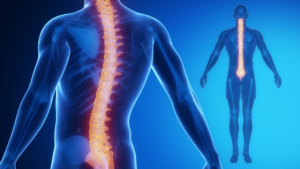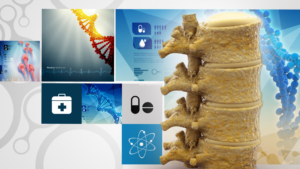Spinal cord stimulation (SCS) has emerged as a transformative approach to managing chronic pain conditions that have proved resistant to traditional therapies. This article delves into the groundbreaking field of SCS, shedding light on its mechanisms, applications, and potential to revolutionize pain management.
Chronic pain conditions represent a significant healthcare challenge, affecting millions of individuals worldwide. When conventional treatments fail, spinal cord stimulation (SCS) offers a promising alternative. This innovative approach has shown considerable efficacy in managing refractory chronic pain conditions, providing relief and improving the quality of life for many patients.

Spinal cord stimulation as a revolutionary approach to pain management
Understanding Spinal Cord Stimulation
SCS involves the delivery of low-level electrical pulses to the spinal cord, interfering with the transmission of pain signals to the brain. This process effectively ‘masks’ pain signals, replacing them with a tingling sensation known as paresthesia.
The Evolution of Spinal Cord Stimulation
The concept of SCS can be traced back to the 1960s, with the introduction of the Gate Control Theory of pain by Melzack and Wall. This theory proposed that non-painful input closes the ‘gates’ to painful input, preventing pain sensation from traveling to the central nervous system. This theory laid the foundation for the development of SCS.
Mechanism of Action
SCS works by modulating the pain signals at the spinal level, before they reach the brain. The electrical pulses delivered by the stimulator compete with the pain signals, effectively ‘drowning them out’ and preventing them from reaching the brain.
Applications of SCS
SCS has been successfully employed in managing various chronic pain conditions, such as:
- Failed Back Surgery Syndrome (FBSS)
- Complex Regional Pain Syndrome (CRPS)
- Ischemic and coronary artery disease
Benefits of SCS
SCS offers numerous advantages over traditional pain management therapies. These include:
- Effectiveness: SCS has shown considerable efficacy in reducing pain intensity and improving the quality of life for patients with refractory chronic pain conditions.
- Customizability: The stimulation parameters can be adjusted to meet the individual needs of each patient, ensuring optimal pain relief.
- Cost-effectiveness: Despite the high initial cost, SCS can be a cost-effective solution in the long run, especially when compared with other long-term therapies.
Challenges and Limitations
While SCS offers numerous benefits, it is not without its limitations. These include the invasive nature of the procedure, potential for complications, and the requirement for ongoing management and adjustment of the stimulator settings.
Advancements in Spinal Cord Stimulation Technology
Over the years, significant advancements have been made in SCS technology. Modern devices are more sophisticated and reliable, offering improved pain relief and fewer complications.
The Future of Spinal Cord Stimulation
The field of SCS is evolving rapidly, with ongoing research and development paving the way for more effective and safer solutions for chronic pain management.
Conclusion
In conclusion, SCS represents a revolutionary approach to chronic pain management. By modulating pain signals at the spinal level, SCS offers a promising alternative for patients who have not found relief through conventional therapies. As research and technology continue to advance, the future of SCS looks promising, offering hope for millions of individuals living with chronic pain. Talk to the professionals at Progressive Pain Management to learn more about spinal cord stimulation therapy and if this treatment is effective for your chronic pain. Fill out the form below to get started.
Spinal cord stimulation therapy is a pain treatment that masks the pain signal before they reach the brain. A device similar to a pacemaker is implanted in the body and delivers electrical pulses to the spinal cord. This is an option for patients with chronic, leg, or arm pain.
What is Spinal Cord Stimulation?
A spinal cord stimulator (SCS) is a small device that is placed under the skin and transmits a mild, low-frequency electric current to the spinal cord. A tiny wire transfers the pulse to the nerve fibers. The SCS minimizes pain because the current modifies and hides the pain signals from reaching the brain.

Spinal Cord Stimulation for Chronic Pain
It is important to note that spinal cord stimulation therapy does not get rid of the source of the pain. It simply runs interference with the signal to the brain. This means that pain relief can vary depending on the patient. The SCS device produces a slight tingling sensation.. It is this sensation that overrides the pain signals. Pain signals travel on the small nerve fibers, whereas the fabricated signals from the SCS travel on larger, more dominant nerves fibers.
The goal of spinal cord stimulation is not to completely erase pain, but to provide a 50-70% reduction. Even the slightest bit of pain relief can be helpful to someone who suffers regularly. Before a permanent spinal cord stimulator is implanted, each patient undergoes a trial to make sure this type of therapy will be effective and reduce their pain.
Why is SCS Used?
Spinal cord stimulation is used to treat neuropathic pain. This is pain that originates from nerve damage. The nerve damage could be caused by injury, accident, or trauma. Patients who are prime candidates for SCS have typically suffered from chronic pain in the lower back, leg, or arm. Commonly, these patients have also had previous surgeries.
More frequently, SCS is being used to avoid back surgery. Other leading causes for receiving SCS therapy is complex regional pain syndrome and peripheral neuropathic pain. Nerve pain that spans beyond damage to the brain and spinal cord, such as from an infection or even amputation or diabetes, is another reason that SCS may be recommended by your physician.
More recently, SCS therapy has been proven to treat a number of chronic visceral pain types, such as abdominal or pelvic pain.
Spinal cord stimulation therapy is used when other treatment types have not been effective in reducing chronic pain or if the patient does not want to undergo surgery. Fortunately, there are no pre-existing medical conditions that would prevent someone from receiving this type of therapy. If you have pain that is caused by a correctable problem (meaning it could be fixed by having surgery or other interventional treatments), SCS is a viable option for reducing your pain.
This type of therapy is more effective when utilized in the earlier stages of a chronic disease or condition, rather than later when a disability has been established.
SCS therapy is used to reduce these types of pain:
- Failed Back Surgery Syndrome: When initial surgery (or surgeries) have been ineffective in reducing pain on a consistent basis.
- Sciatica or Arm Pain: Persistent pain caused by arthritis, spinal stenosis, or extensive nerve damage.
- Complex Regional Pain Syndrome: When patients experience severe chronic pain, typically in their hands or feet.
- Arachnoiditis: This is painful inflammation and scarring of the protective lining of spinal nerves
Other types of pain caused by stump pain, peripheral vascular disease, multiple sclerosis, or a spinal cord injury may be reduced by the use of a spinal cord stimulator.
Benefits of Spinal Cord Stimulation
Spinal cord stimulation therapy reduces the number of abnormal pain signals from reaching the brain. However, it also helps the body restore pain-inhibition pathways that have been lost. Pain-inhibitory pathways essentially work as a gate-keeper. They control how much pain is received by the brain. SCS therapy harnesses the body’s natural pain-relieving chemicals that are used by nerve fibers to communicate with each other. Not only does this whole process reduce pain, but it increases microcirculation.
It is reported that 50-70% of patients who are candidates for SCS therapy experience 50% reduction in pain. An even higher proportion can expect to experience a 30% reduction in pain levels. For many patients who suffer from chronic pain, even the smallest amount of pain relief is welcomed. This has a profound effect on improving the quality of life in patients who have suffered from long-term chronic pain.
Learn more about spinal cord stimulation and how it works for treating chronic pain, fill out the form below and get in touch with the team at Progressive Pain Management today.

